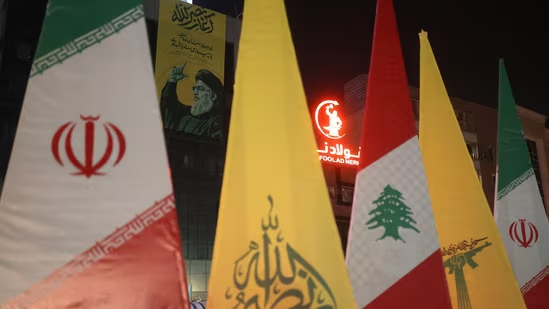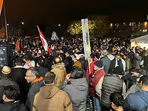Why are Israel, Hezbollah and Iran fighting? A timeline of the conflict
Israeli Prime Minister Benjamin Netanyahu on Tuesday vowed to retaliate against Iran after the latter launched 200 missiles into Israeli territory in a cycle of strikes and counter-strikes that have taken over the Middle-East.

While in recent weeks, the fraught relations between Israel, Iran and militant group Hezbollah have come to a head, the roots of this aggression can be traced decades back, starting from 1979.
Also Read: Iran attacks Israel, fires nearly 200 missiles; PM Benjamin Netanyahu says Tehran 'will pay for it’ | 10 updates
Here is a timeline of events that became a catalyst to the conflict we see in the region today:
Nuclear ambitions and anti-USA sentiment
In 1979, Iran overthrew it's last monarch Shah Mohammad Reza Pahlavi during the Islamic revolution, and aligned itself with other militant groups demanding freedom in the region such as the Hezbollah in Lebanon and Hamas in Palestine.
While this period brought Iran and Hezbollah together, relations with neighbouring country Israel suffered due to the continued marginalisation of the Palestinians. An anti-American sentiment also distanced Iran from Israel, which was allied with the USA.
Also Read: ‘David's Sling’, ‘Arrow’, ‘Iron Dome’: How Israel intercepted Iran's 200 missiles
At the same time, Iran allegedly conducted covert operations to thwart Iran's emerging nuclear programmes as the country became a threat within the region.
October 7, 2023 - fuel to the fire
While minor clashes occurred consistently during the Syria war and Israel's encroachment over Golan Heights in Syria, the conflict between Israel and Iran remained hidden and simmering.
Also Read: Trump blasts Biden and Harris over Iran's attack on Israel, says ‘neither has any idea what is even going on’
However, October 7, 2023 changed the nature of the conflict on a global stage. On October 7, Palestinian militant group Hamas led an operation in Southern Israel leading to several deaths.
Israel promptly reacted against the aggression and launched a series of strikes and ground invasions in Gaza, which has left 41,600 people dead due to bombings and famine, according to the Palestinian health ministry.
Though Iranian authorities denied any knowledge of the events that took place on October 7, the Israeli government blamed Iran as well due to its ties to Hamas.
On October 17, Iran's supreme leader Ayatollah Ali Khamenei condemned Israel, saying, "If the crimes of the Zionist regime continue, Muslims and resistance forces will become impatient, and no one can stop them."
Initial reports of firing between Hezbollah and Israeli forces on the border of Lebanon were also reported during this period, according to Al Jazeera.
Direct attacks
In December, Iranian state media reported that an Israeli air strike in Syria had killed Sayyed Razi Mousavi, a senior leader of Iran’s Islamic Revolutionary Guard Corps (IRGC).
A month later, Iran accused Israel of bombing a building in Damascus, killing five more members of the IRGC. Another bombing in March also killed two IRGC members in Damascus.
In April, Iran received a major blow after its consulate in Syria was destroyed by an Israeli aIr strike. Thirteen people were killed including a senior commander of the IRGC - Brigadier General Mohammad Reza Zahedi.
In response to this Israeli offensive, Iran launched more than 300 drones and missiles against Israel, in an operation dubbed ‘True Promise’.
September 17 - Pager blasts
On September 17, hundreds of pagers simultaneously exploded across Lebanon and some parts of Syria, targeting Hezbollah operatives and leading to the deaths of civilians and militant leaders alike.
Following these, Israel also launched a series of air strikes in the densely populated Dahiye region of Beirut, where they were allegedly targeting Hezbollah operatives.
On September 26, around seven buildings were levelled under the immense bombardment which went on for days, culminating in the loss of key Hezbollah leader Hassan Nasrallah.
On September 30, the Israeli military also announced that it would begin ground incursions to root out “Hezbollah terror targets”. Iran's supreme leader Ayatollah Ali Khamenei was also supposedly sent to a safe location, a reported news agency AFP, amid concerns about threats to his life as well.
On October 1, Iran launched 200 missiles towards Israel as a response to the death of Hezbollah operatives and Lebanese civilians caused by Israeli airstrikes.
Israeli forces immediately counter attacked with five more air raids in Lebanon targeting Hezbollah members and promised to retaliate towards Iran.
Disclaimer: The copyright of this article belongs to the original author. Reposting this article is solely for the purpose of information dissemination and does not constitute any investment advice. If there is any infringement, please contact us immediately. We will make corrections or deletions as necessary. Thank you.
Title:Why are Israel, Hezbollah and Iran fighting? A timeline of the conflict
Url:https://www.investsfocus.com









